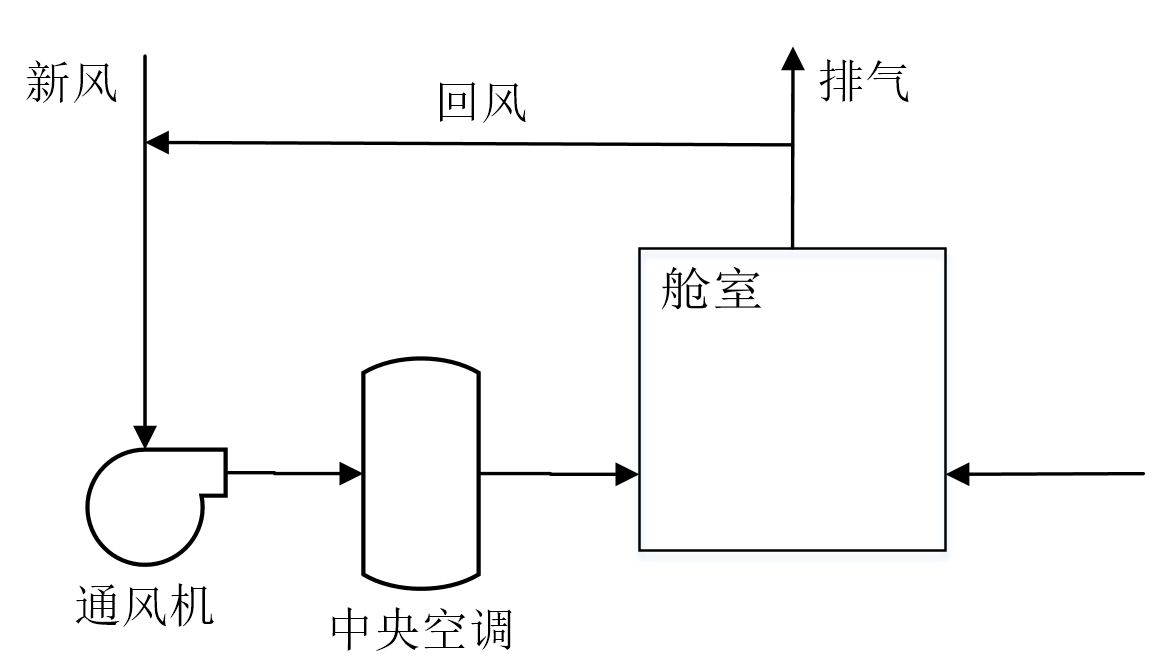邮轮舱室温度控制系统研究毕业论文
2020-04-12 08:46:29
摘 要
邮轮在海上运行时,邮轮舱室的温度越加引起人们的重视。首先,人们对于环境温度的舒适度要求越来越高,因此,有一个良好的工作和生活的舱室温度环境就显得尤为重要,这就需要更加高效的中央空调系统。其次,相比较与传统空调耗电量大,灰尘等污染物多等温度控制不理想的缺点,新的中央空调技术能很好的改善这些缺点,让人们感受到更加舒服的室温环境,因此,各个国家都在大力开放新的中央空调控制系统。
传统的中央空调技术耗电量大,控制单一,效果差。因此,研究新的中央空调技术就成为了重中之重,新式的中央空调技术有三种新式,第一种是独立新风控制系统,它可以单独控制每个房间的温度,满足了邮轮舱室各自不同的温度要求,方便灵活。第二种是变风量控制系统,是通过改变输送风量的大小来调节温度。具有单个区域的控制能力,在局部区域具有不错的灵活性等优点。与传统的定风量控制系统相比,变风量控制系统能更好的调节局部区域的温度,实现温度的独立控制,避免在局部区域产生过冷或者过热的现象。第三种是定风量双风道系统,它拥有两条送风道,分别输送冷风和热风,然后把冷风与热风按照一定的比例混合后,在输送入室内,双风道系统中冷风使用冷却水进行冷却,热风直接利用回风,利用了室内的热量,双风道系统保持了总的送风量恒定,但是缺点是无法独立的控制每个舱室的温度。
本文将使用matlab仿真软件中的simulink工具对邮轮的舱室温度进行数学建模与仿真,并根据神经网络自学习的原理,设计一种基于神经网络的智能温度控制系统,使得邮轮舱室温度能适应海上的环境变化和舱室的人员变化。通过模拟海上的各种复杂情况,来检验基于神经网络的智能控制器的可行性。
最后,对独立新风系统与变风量系统的能量损耗进行对比分析,通过对比来比较独立新风系统相对于变风量系统的优缺点,做出结论,对经济性进行分析,通过simulink仿真得出温度控制曲线进行证明,使得中央空调更加完善,更有利于人们的工作和生活。
关键词: 独立新风 变风量 simulink仿真 数学建模 神经网络自学习
Abstract
When the cruise ship is operating at sea, the temperature of the cruise ship cabin is getting more and more attention. First of all, people have higher and higher requirements for the comfort of the ambient temperature. Therefore, it is particularly important to have a good working and living cabin temperature environment, which requires a more efficient central air-conditioning system. Second, comparing with the disadvantages of traditional air conditioners such as large power consumption, dust and other contaminants that are not ideal for temperature control, the new central air conditioning technology can very well improve these shortcomings and make people feel more comfortable at room temperature. Therefore, Various countries are vigorously opening up new central air conditioning control systems.
The traditional central air-conditioning technology consumes a large amount of electricity, has a single control, and has poor results. Therefore, research on new central air-conditioning technology has become a top priority. There are three new types of new central air-conditioning technology. The first is an independent new air control system, which can individually control the temperature of each room and meet the different requirements of the cruise ship cabins. The temperature requirements are convenient and flexible. The second is the variable air volume control system, which is to adjust the temperature by changing the size of the delivery air volume. With a single area of control, in the local area has good flexibility and so on. Compared with the traditional constant air volume control system, the variable air volume control system can better adjust the temperature of the local area, achieve independent control of temperature, and avoid the phenomenon of over-cooling or overheating in a local area. The third type is the constant air volume dual air duct system. It has two air supply ducts for conveying cold air and hot air, and then mixes the cold air and hot air according to a certain ratio and then transports them into the room. The cold air in the dual duct system uses cooling. The water is cooled, the hot air directly uses the return air, and the indoor heat is utilized. The double air duct system keeps the total air supply constant, but the disadvantage is that the temperature of each cabin cannot be controlled independently.
This article will use the simulink tool in the Matlab simulation software to mathematically model and simulate the cabin temperature of the cruise ship. According to the neural network self-learning principle, an intelligent temperature control system based on the neural network is designed to make the cabin temperature of the cruise ship adapt to the sea. The environment changes and the personnel of the cabin change. By simulating various complex situations at sea, the feasibility of an intelligent controller based on neural networks is examined.
Finally, compare and analyze the energy loss between the independent fresh air system and the variable air volume system, compare the advantages and disadvantages of the independent fresh air system with respect to the variable air volume system, make conclusions, analyze the economy, and obtain the temperature control through simulink simulation. The proof of the curve makes the central air-conditioning more perfect and more conducive to people's work and life.
Key Words: independent fresh air variable air volume simulink simulation mathematical modeling neural network self-learning
目 录
摘 要 I
Abstract II
第1章 绪论 1
1.1课题研究背景 1
1.2选题研究意义 1
1.3国内外研究现状 2
1.3.1国外独立新风系统空调研究现状 2
1.3.2国内独立新风系统空调研究现状 2
1.3.3国外变风量系统空调研究现状 3
1.3.4国内变风量系统空调的研究现状 4
1.4课题研究内容 5
第2章 独立新风系统的原理与送风形式 6
2.1传统空调的不足之处 6
2.2独立新风系统的原理 6
2.3独立新风系统的送风形式 7
2.4独立新风系统优点 9
2.5本章小结 9
第3章 舱室温度控制系统建模 11
3.1 matlab建模 11
3.2建立数学模型 11
3. 3邮轮舱室传统PID温度控制系统simulink建模仿真 15
3.4本章小结 17
第4章 神经网络温度控制器设计与仿真 18
4.1人工神经网的基本原理 18
4.1.1人工神经网络的现状 18
4.1.2人工神经网络的局限性和趋势 19
以上是毕业论文大纲或资料介绍,该课题完整毕业论文、开题报告、任务书、程序设计、图纸设计等资料请添加微信获取,微信号:bysjorg。
相关图片展示:











